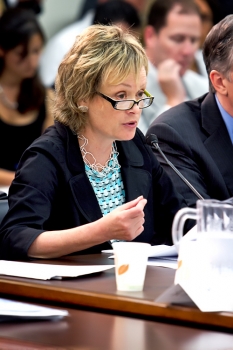Guest blog post by Leslie Harris, President and CEO of the Center for Democracy & Technology.
Today the Administration released an ambitious, long-term strategy document called the National Strategy for Trusted Identities in Cyberspace (NSTIC). The Strategy puts forth a vision where individuals can choose to use a smaller number of secure, privacy-preserving, and convenient online identities. This would be a shift away from today’s norm of numerous usernames, passwords, and online accounts scattered across the Web.
Importantly, the Administration has turned to the private sector to make this vision a reality. The Strategy is not a national ID program—in fact, it’s not an ID “program” at all. It is a call for leadership and innovation from private companies. The government’s role must now be to advocate for its citizens and to support the development of a fair and useful system.
Why should the American people care about a “strategy” for Internet identity?
First, a growing number of our Internet transactions require an identity. We’re continually prompted to create new accounts to participate in online social networking, shopping, banking, and forums. Most of us have no idea how our identifying information will be used or shared. It certainly doesn’t help that we have to offer a fresh set of information to every new service that comes along. Without a new approach, this trend will continue. We deserve better control over our identity and stronger assurances that it will not be misused. Innovation isn’t slowing down; we have to catch up.
Secondly, services that will make our lives easier and more convenient—sometimes involving highly sensitive information—are still waiting to come fully online. Health care and government services are slowly staking out an Internet presence, but they will remain at the starting line until a reliable and trustworthy platform for establishing and confirming user identity exists.
We’re pleased to see the Strategy has made individuals its first priority. The Administration must remain firmly dedicated to an identity ecosystem that is voluntary, protective of privacy, affords users a wide variety of choices for whether and how they will convey their identity online, and compliant with a full set of Fair Information Practice Principles. This effort must also be built on the foundation of comprehensive privacy legislation. We encourage the Administration to incorporate its existing support for baseline privacy legislation with the Strategy’s implementation.
Finally, the Strategy recognizes that anonymity and pseudonymity—crucial elements of our privacy and First Amendment rights—are and must remain vital characteristics of the Internet alongside any new identity ecosystem.
The Strategy is the beginning of a long journey through complicated technology standards and policy rules. If its vision is realized, consumers, businesses, and governments all have a lot to gain. It will only succeed, however, with meaningful engagement from all stakeholders. We are eager to see the Strategy’s implementation plan and hope the Strategy leads to a productive partnership.



Comments Closed
Due to increased spam, comments have been closed on this content. If you wish to comment about the content, we encourage you to email webmaster@doc.gov.